A rare early American themed plate
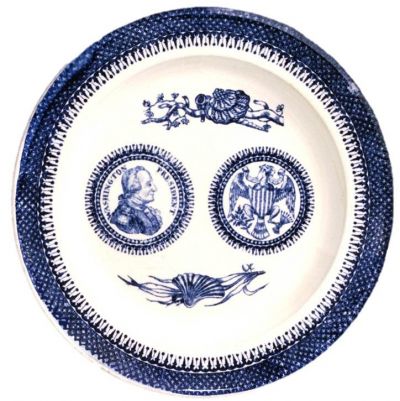 This rare survival of the 1790s is an earthenware plate with an under-glaze blue printed pattern celebrating George Washington's presidency of the United States of America. Only seven examples with this print are known.
This rare survival of the 1790s is an earthenware plate with an under-glaze blue printed pattern celebrating George Washington's presidency of the United States of America. Only seven examples with this print are known.
The trellis-diaper and dagger border is more usually found on a pattern popularly known as Fitzhugh, made in Chinese porcelain and copied by the Staffordshire potters. However in this design, the centre of the Fitzhugh pattern has been replaced with two medallions and two shell and seaweed motifs.
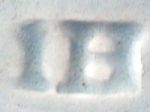 The plate is impressed on the back with the initials IH, the mark of the potter. The old English alphabet had only 24 letters, and I and J were interchangeable. IH is found on a wide range of pottery with various kinds of decoration, indicating a
factory
that was in business for a number of years. John Harrison of
Stoke-upon-Trent who was in active from about 1780 to about 1815 is the only potter who may be considered a viable candidate for the manufacturer of this plate.
The plate is impressed on the back with the initials IH, the mark of the potter. The old English alphabet had only 24 letters, and I and J were interchangeable. IH is found on a wide range of pottery with various kinds of decoration, indicating a
factory
that was in business for a number of years. John Harrison of
Stoke-upon-Trent who was in active from about 1780 to about 1815 is the only potter who may be considered a viable candidate for the manufacturer of this plate.
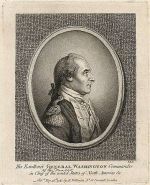
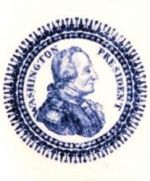 The medallion to the left on the plate is
engraved with a portrait of George Washington and inscribed WASHINGTON
PRESIDENT. Washington was an American icon, “first in war, first in
peace, and first in the hearts of his countrymen”[1] and
in 1787 he was unanimously elected America’s first president. The
portrait of Washington seen in this print ultimately derives from a pencil
drawing by Pierre Eugène du Simitière a Swiss artist working in America
recording the struggles and emergence of the new nation.[2]
In 1779 Du Simitière’s completed his Washington drawing and, together with
portrait drawings of thirteen other revolutionary war heroes, dispatched it to
France for engraving. A few sets of prints were supplied by 1781, but it
was the Washington portrait that drew most attention. After the revolutionary
war, the prints were widely copied in Europe. The whole set of thirteen
subjects was published by two different London printers in May 1783, and
following those editions, the Washington portrait became a popular source for
book and magazine illustrations.[3]
George Washington was President from April 1789 to March 1797. He died in
1799 and it is likely that the plate was made during the presidency rather than
as a memorial after his death.
The medallion to the left on the plate is
engraved with a portrait of George Washington and inscribed WASHINGTON
PRESIDENT. Washington was an American icon, “first in war, first in
peace, and first in the hearts of his countrymen”[1] and
in 1787 he was unanimously elected America’s first president. The
portrait of Washington seen in this print ultimately derives from a pencil
drawing by Pierre Eugène du Simitière a Swiss artist working in America
recording the struggles and emergence of the new nation.[2]
In 1779 Du Simitière’s completed his Washington drawing and, together with
portrait drawings of thirteen other revolutionary war heroes, dispatched it to
France for engraving. A few sets of prints were supplied by 1781, but it
was the Washington portrait that drew most attention. After the revolutionary
war, the prints were widely copied in Europe. The whole set of thirteen
subjects was published by two different London printers in May 1783, and
following those editions, the Washington portrait became a popular source for
book and magazine illustrations.[3]
George Washington was President from April 1789 to March 1797. He died in
1799 and it is likely that the plate was made during the presidency rather than
as a memorial after his death.
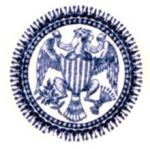
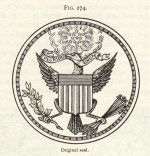 The medallion to the right of the plate has an engraved image based on the
Great Seal of the United States. Commissioned on July 4, 1776, by the
Continental Congress of the newly established United States, it took six years
and the combined efforts of 14 men before the Great Seal of the United States
was finally adopted on June 20, 1782. The most prominent feature on the obverse
of the Great Seal is the figure of an American bald eagle facing proper right
and with wings outstretched, bearing a shield, with 13 vertical
stripes. The motto E Pluribus Unum, (Out of Many, One) has 13 letters placed on a
scroll held in the eagle’s beak, The
eagle holds an olive branch in its proper right talon, and a bundle of 13
arrows in his left talon, together these symbolized the power of peace and war,
which is exclusively vested in Congress. Above the head of the eagle, in
the official design was a radiant constellation of 13 stars with rays of light
breaking through a cloud, signifying the new nation taking its place among
other sovereign states. The design of the great seal with its emphasis on the number 13 powerfully conveys the unity of the 13 original states that formed Confederacy of the United States. This relatively simple, bold image was perfect for use in printed pottery made for the
American market.
The medallion to the right of the plate has an engraved image based on the
Great Seal of the United States. Commissioned on July 4, 1776, by the
Continental Congress of the newly established United States, it took six years
and the combined efforts of 14 men before the Great Seal of the United States
was finally adopted on June 20, 1782. The most prominent feature on the obverse
of the Great Seal is the figure of an American bald eagle facing proper right
and with wings outstretched, bearing a shield, with 13 vertical
stripes. The motto E Pluribus Unum, (Out of Many, One) has 13 letters placed on a
scroll held in the eagle’s beak, The
eagle holds an olive branch in its proper right talon, and a bundle of 13
arrows in his left talon, together these symbolized the power of peace and war,
which is exclusively vested in Congress. Above the head of the eagle, in
the official design was a radiant constellation of 13 stars with rays of light
breaking through a cloud, signifying the new nation taking its place among
other sovereign states. The design of the great seal with its emphasis on the number 13 powerfully conveys the unity of the 13 original states that formed Confederacy of the United States. This relatively simple, bold image was perfect for use in printed pottery made for the
American market.
[1] Quotation
from Henry Lee’s resolution passed by Congress upon the death of George
Washington in 1799
[2] Wendy
C. Wick. George Washington and American Icon
The Eighteenth-Century Graphic Portraits A Barra Foundation Book, Smithsonian Institution, 1982.
pp. 22-24
[3]Wendy
C. Wick. George Washington and American Icon
The Eighteenth-Century Graphic Portraits A Barra Foundation Book, Smithsonian Institution, 1982. p.26
